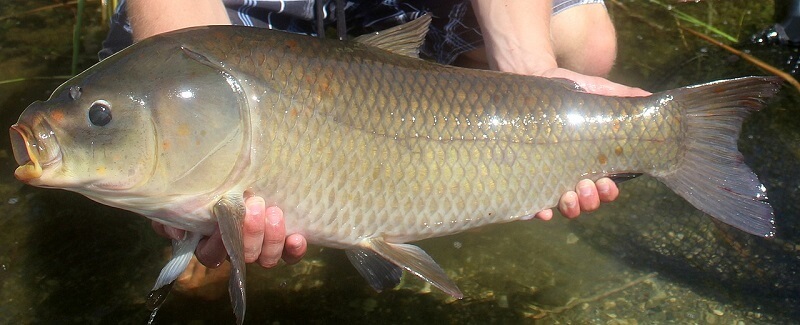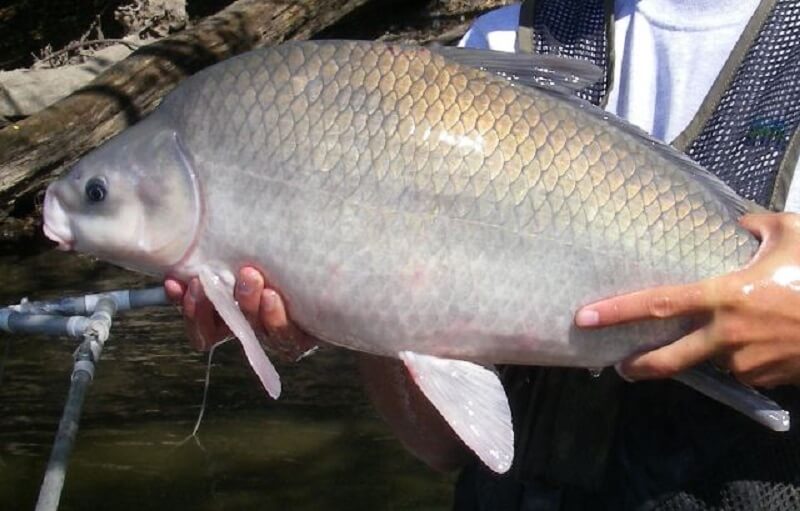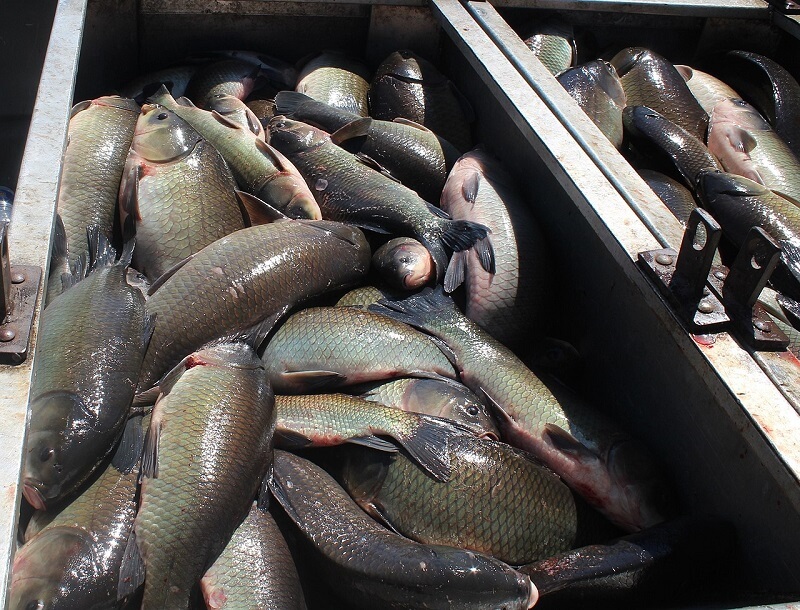
| Kingdom | Animalia |
| Phylum | Chordata |
| Class | Actinopterygii |
| Order | Cypriniformes |
| Family | Catostomidae |
| Genus | Ictiobinae |
| Species | 5 distinct species |
| Niche | Apex Predator |
| Length | Up to 4 feet (1.2 m) |
| Weight | Up to 82 lbs (45-70kg) |
| Lifespan | Up to 112 years! |
| Social Structure | Solitary to Gregarious |
| Conservation Status | Least Concern, though some places have specific protections |
| Preferred Habitat | Quickly moving streams with aquatic vegetation |
| Average # of eggs | 250,000 eggs per kg – roughly 12.5 million eggs per adult over a lifetime! |
| Main Prey Species | Aquatic vegetation, detritus, plankton, and larvae |
| Predators | Many other fish as juveniles, few natural predators as adults, Humans |
The Basics
The buffalo fish is a genus of large suckerfish that includes several different species. The largest among these, Ictiobus bubalus, can grow to over 80 pounds! Ironically, the common name for the largest of the buffalo fish is the “Smallmouth Buffalo” – maybe a tribute to the fish’s massive body compared to its small, downward-facing mouth.
While the Smallmouth Buffalo only lives around 18 years at most, their cousin the Bigmouth Buffalo (Ictiobus cyprinellus) can live up to 112 years! This puts it in a rare category of animals that live beyond 100 years. Despite its common name, the Bigmouth Buffalo is slightly smaller than the Smallmouth, maxing out at 65 pounds.
All buffalo fish are part of the suckerfish family. This group of fish has adapted a bottom-facing mouth, allowing them to scrape algae of off rocks, suck up detritus out of the muck, and pick up the small scraps of food and nutrients that drift to the bottom of a body of water.
For this reason, some cultures describe the buffalo as “rough” and inedible, while others readily consume buffalo in a variety of forms. One of the most popular forms is fried buffalo, eaten in a variety of places along the Mississippi River.

Fishing for Buffalo?
Buffalo fish prefer the sluggish areas of rivers with high amounts of vegetation and are sometimes found in lakes. Because buffalofish are bottom feeders, your best chance of catching a buffalo is to bait your hook with corn and weight it so the bait is suspended just above the bottom of the lake or river.
Another common method of fishing for buffalo is night bow fishing with the aid of a light. The light attracts the buffalo fish to the surface, where they can be shot with a fishing-modified bow and arrow and reeled in. While this method is becoming more popular, it also drastically increases the average harvest of a fisherman. Until the appropriate laws are passed to protect the buffalo fish populations, fishermen should be very careful to not harvest more fish than they need.
Buffalo prefer high areas of vegetation because they lay their eggs in areas with slightly exposed aquatic vegetation. Buffalo fish fry (babies) feed on microscopic algae and plankton. It takes a buffalo fish of all species nearly a decade to mature, and the largest fish produce the most eggs. So, this species is likely to be negatively affected greatly by trophy seekers who remove or kill the oldest individuals.
Interesting Insights from the Buffalo Fish!
The buffalo fish is a genus that has adapted to life at the bottom of a murky, quickly moving stream. As such, it displays many adaptations to this environment. These adaptations, and other aspects of the buffalo fish, lend evidence to some very interesting biological concepts and theories.
Feeding Adaptations
Many fish have developed a special method to feed. Water is a competitive place, so any advantages you may have over the competition can mean the difference between life and death. In the case of the buffalo fish, they have become perfectly adapted to life on the bottom of murky rivers and lakes.
Buffalo fish have a downward-facing mouth, capable of scraping algae directly from rocks and sucking bits of food out of the silt and sand on the bottom of a waterway. Buffalo fish, like other algae-eating fish, also have a number of gill rakers.
Gill rakers are bony protrusions that sit in front of the gills and filter out all sorts of microscopic organisms. Like other types of algae-eating fish, the buffalo fish gathers some amount of algae simply by swimming through algae-dense waters. This makes gathering food a somewhat passive process, part of the reason buffalo fish can be so huge!

Dams and Fish Reproduction
Like many species of river-dwelling fish, buffalo fish are having a lot of trouble with dams. Dams are typically built for two reasons: storing water or creating energy. Sometimes, dams serve both of these purposes.
However, many dams were engineered without fish in mind. Fish often eat and grow in one area of a river system, while migrating to other areas to reproduce. Many species try to travel upstream to reproduce, and without dams, the buffalo fish is no exception. With dams – the buffalo fish has an incredibly hard time traveling upstream to reproduce.
One study found that on a dam built nearly 70 years ago, the only individuals left in the lake above the dam were around 80 years old – a sign that few to no new individuals were finding their way to the lake in over 70 years! Unless designed with fish in mind, dams often harm many local species because they block the natural flow of fish to different parts of the river.

Supercentenarian Longevity
Try saying that 5 times, quickly! A “supercentenarian” is an organism that lives for 100+ years. Interestingly, only one species of buffalo fish is a “supercentenarian” and that is the Bigmouth Buffalo.
The Smallmouth buffalo may only live up to 18 years, but the Bigmouth Buffalo has some sort of genetic adaptation that has allowed it to live for nearly 5X-6X longer!
Scientists can confirm the age of a fish by measuring a bone called the otolith, which lies in the inner-ear. Fish use these bones for hearing and balance, and a new ring of calcium and minerals are added to the otoliths each year as a fish grows. This is how scientists confirmed that Bigmouth Buffalo fish is one of the longest-lived fish species, though we still don’t know why or how they do it!
